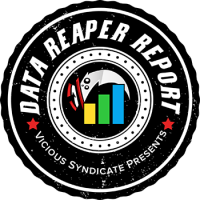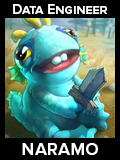
Welcome to the 80th edition of the Data Reaper Report! This is the first report after the 10.2 balance changes.
Our Data Reaper Project, including the Data Reaper Live has 3,500 active contributors. Without them, this project would not be possible, so we’d like to thank all of our contributors for their help.
Quick Links
Class/Archetype Distribution | Class Frequency | Matchup Winrates | vS Power Rankings | vS Meta Score | Class Analysis & Decklists | Meta Breaker of the Week | How to Contribute | Credits
Number of Games
| Overall | 95,000 |
| Legend | 2,500 |
| Ranks 1-5 | 25,000 |
| Ranks 6-10 | 27,000 |
| Ranks 11-15 | 30,000 |
Class/Archetype Distribution
[TABS_PRO id=12306]
Class Frequency
[TABS_PRO id=12307]
Class Frequency Discussion
When it comes to Warlock, there are no surprises. The class has risen in play after the patch and has become the most popular at all levels of play. Control Warlock is the most prevalent archetype, and it’s going through an interesting refinement stage. The lines between different variations of “Control” and “Cube” are even more blurry than before, with many hybrid variants appearing as the archetype attempts to optimize itself for the new meta. It will likely take a couple more weeks to flesh out. Zoo has also changed drastically and carries several different approaches, making it one of the least refined early game decks in the current meta.
The Mage class has gone through the most drastic spike in popularity, with Secret Mage exploding into the scene. It is the 2nd most prevalent archetype at all levels of play behind Control Warlock. Big-Spell Mage is also present, with relatively modest numbers, while Exodia Mage stays very niche.
The destruction of Patches has led Paladin to also significantly rise in popularity. Much like Mage, Paladin carries an incredibly strong non-pirate early game with the murloc tribe, which elevated Murloc Paladin towards the top of the frequency charts. Other Paladin archetypes are not too popular, but they are noticeable. Control Paladin has reappeared following Raza’s fall, while the buds of other early game strategies, Aggro and Dude Paladin, are also showing.
While Priest did drop in representation following the complete disappearance of Razakus Priest, the class has quickly recovered with the rise of other strategies. Spiteful, Combo and Big Priest have all established a significant presence in the new meta, and Priest is noticeably more popular at higher levels of play. Spiteful Priest is the most common Priest archetype, though much like before the patch, it declines in its numbers as you climb the ranks. In contrast, Combo Priest grows in popularity at higher levels of play, and is the most common Priest archetype at legend ranks. One other archetype that only started to get noticeable as we closed the weekly database is Control Priest, so we will have to wait and see whether it gains significant traction in the coming days and how it shapes out.
Hunter numbers have picked up following the patch and it currently boasts three distinct archetypes, each displaying a modest share of the field: Aggro, Secret and Spell Hunter. Spell Hunter is the archetype that has gained the most traction recently and is relatively more popular than other Hunter decks at higher levels of play. This marks quite the comeback for the archetype that had an incredible first few days after the launch of K&C before fizzling out completely. We’ll have to wait and see whether or not it does it again.
Rogue has seen the most drastic decline in play, and while Tempo Rogue is still present in the current meta, it has almost disappeared from the game and sits at a distant 3rd when it comes to Rogue archetypes. Kingsbane Rogue is the deck of choice at lower skill levels, while Miracle Rogue is favored from rank 5 onwards. The class seems to have certainly taken a big hit following the balance changes and is nowhere near as relevant as before.
Much like Rogue, Druid has also fallen off pretty hard in play rates. Aggro and Jade Druid are noticeably present, but have no more than niche representation in the new meta. However, the class is quickly changing, with Spiteful Druid gaining traction over the last couple of days, and judging by the pace of its climb, it’s likely going to have a bigger share of the meta by next week.
Shaman has seen a very small climb in popularity, and Token Shaman is displaying a usage pattern resembling an actual Hearthstone deck, but it’s hard to say whether this lasts. Meanwhile, Warrior has crashed even further down the rabbit hole, and took over Shaman as the bottom of the barrel class. Pirate Warrior, the last playable Warrior deck in K&C, looks dead.
[TABS_PRO id=12308]

[TABS_PRO id=12309]
vS Meta Score
[TABS_PRO id=12310]
vS Power Rankings Discussion
We have many stories to tell. Let us first talk about Murloc Paladin before we get to the noticeable elephant (or dude) in the room. Murloc Paladin looks very powerful to us, with a matchup spread that’s quite absurd. With Tempo Rogue dead in the water and no Patches around, Paladin’s early game is so much stronger against the field. Control Warlock is the one prevalent counter that stops the angry fish men from breaking the game. Judging by these results, Hungry Crabs will likely make a big comeback, and we’re already seeing them appearing in aggressive Druid and Hunter lists. This meta is very mrgl.
Dude, Paladin? Even though Murloc Paladin is extremely powerful, it’s not even the highest win rate archetype from rank 5 onwards in its own class. This seat is taken by Silver Hand Recruit, or Dude Paladin. The forgotten archetype has reappeared and is looking strong, despite an awful matchup against Control Warlock and builds that are still very much in an experimental phase (!!!). We will say that the sample size is quite low at the moment for the archetype. We don’t expect Dude Paladin’s win rate to stay this high once it climbs in popularity and players understand what they’re running into, but this is an interesting finding nonetheless. It does suggest that the Paladin class has really strong alternatives in the case Murloc Paladin gets hard targeted by Hungry Crabs, with Aggro and Dude Paladin looking so strong as well. Call to Arms is a hell of a card (might be the best one in the format) and is carrying these strategies to crazy power levels.
Control Warlock is looking very strong in the current meta considering what we’ve said earlier: it has yet to be figured out after the patch and there are many different approaches being tested and optimized. The meta is relentless in its attempts to counter Warlock, so it’s overcoming quite a bit of hostility from the field while still boasting a very good win rate. Looking at the power level of Paladin and the fact Warlock is its most effective counter class; Control Warlock will likely remain a dominant strategy going forward. On the other hand, Zoo Warlock has taken a big hit in its performance level as a result of the balance patch, but we strongly suggest that it should not be written off as weak or mediocre: its scope for improvement is also significant and it’s too early to tell how it pans out.
Secret Mage completes the trifecta of strategies that define the meta at the moment. The archetype has one of the strongest matchups against Control Warlock, and is pretty powerful against slower decks in general. Aggressive strategies remain its biggest counters (With Murloc Paladin being the hardest matchup), but the balance changes have certainly helped make some of these matchups not as awful as they were before. Other Mage decks are not so lucky, with Big-Spell struggling to balance itself between the Control Warlock matchup and the aggressive matchups, while Exodia is even weaker than before the patch due to the loss of the Raza matchup.
Raza down? No problem! Priest still has a multitude of great options to choose from on ladder. As we’ve predicted, Big Priest has seen a big increase in its win rate and is looking like one of the strongest decks in the game. Spiteful Priest has shrugged off the loss of some of its strong neutral cards to maintain a decent power level. Combo Priest is the one archetype that we were off about. The Razakus Priest matchup was its bread and butter in the previous meta, so we had some doubts on how good it would be after the patch, but the disappearance of Tempo Rogue and the generally slower early game meta helped the archetype a lot. According to our internal metrics, it also has the highest skill cap in the game at the moment, performing much better at higher levels of play. If you’re looking for a challenging deck to master, look no further than Combo Dragon Priest.
The state of Hunter looks quite interesting. The minion-focused Aggro Hunter builds have taken a hit in their performance levels, which was expected due to the loss of Corridor Creeper and Patches. However, secret-focused strategies have significantly strengthened. Spell Hunter, in particular, has skyrocketed into quite a strong place in the meta. However, Spell Hunter does carry some concerns, boasting a very polarizing matchup spread, which means its strength is very dependent on future meta shifts and which strategies rise and fall.
Druid’s prevalence lines up with its win rate struggles quite perfectly. Both Jade and Aggro Druid are crumbling under the onslaught of Control Warlocks. The best performing Druid archetype at the moment is Spiteful Druid, which has seen quite a few innovations in recent days and is currently on an upward trajectory.
Things are not looking good for Valeera, with Tier 4 filled with poorly performing Rogue decks. We don’t rule out Tempo Rogue turning things around since the archetype is currently very poorly optimized for the current meta. There is plenty of room for refinements and improvements, but it’s safe to say that it’s not going to be the dominant force it used to be. Kingsbane Rogue continues to be a lovable, yet very flawed deck that dies to things that hit it in the face, while Miracle faces a similar issue.
Token Shaman is not as bad as it used to be, and it definitely appreciates the disappearance of Razakus Priest, one of its nightmare matchups. However, dealing with Warlocks and Priests isn’t very fun in the new meta either, and the archetype is still mostly outclassed by other strategies. Another deck that has climbed from the bottom of the barrel as a result of Raza’s disappearance is Control Paladin. While its win rate isn’t stellar, it’s much better than it used to be, and we think it can look better once players gravitate to the strongest win condition. There are Exodia builds, N’Zoth builds and hybrid builds carrying both the Exodia/Beardo package and N’Zoth. The strongest approach by a significant margin is the pure Exodia build.
You may have noticed it by now, but Warrior is completely missing from the power rankings and the matchup table. The reason is simple: the class is dead. Not a single Warrior archetype even boasts reasonable data to analyze, and from the little data we have on Warrior, it’s looking atrocious. Record breaking bad. If we had a Tier 5, that’s where Warrior would be.
Class Analysis & Decklists
Druid | Hunter | Mage | Paladin | Priest | Rogue | Shaman | Warlock | Warrior
While we’re not ready to say that Warlock is the best class, we are ready to say that it’s the most played class. That’s to be expected after a round of balance changes that left most of its rivals severely weakened.
Control Warlock is the most popular archetype in the game and is heavily represented on ladder. The synergy between Possessed Lackey and Voidlord continues to stop aggressive decks in their tracks (unless Spellbreaker is around), along with the copious removal suite and exceptional lifegain capabilities. Combine that with late game inevitability through N’Zoth and Gul’dan and you’ve got a winning recipe for a very powerful archetype.
In terms of builds, things have blurred out even more between defensive Rin variants that look to win mostly through fatigue, and aggressive variants that run the Cube package with Doomguards. For starters, N’Zoth has become a more common card in all late game Warlock decks because of its importance in the mirror matchup which often turns into a grind fest that goes into fatigue. Umbra is far less effective because the burst combo she enables often runs into a wall of Voidlords. Furthermore, Cube Warlocks have begun to run more defensive early game cards to fend off aggressive decks such as Murloc Paladin and Secret Mage, as displayed in Feno’s list running Tar Creeper and Doomsayer. Other decks run Plated Beetle and Stonehill Defender in those spots. Finally, even in decks that do not run the Cube package, we can often see more proactive options as evidenced by Leta’s #1 legend Rin Warlock that also includes Mountain Giants, a generally strong card in the mirror.
To conclude, the archetype is currently under heavy experimentation and a post-patch optimal build has not been figured out for ladder play. The spectrum of options between proactivity and reactivity is very wide, and there is a lot of overlap in approaches. It’s very important to understand the merit of each card in order to fine tune your build to perform best against what you’re facing.
Zoo Warlock is in a similar spot where it currently sees quite a few different approaches. With the change to Patches, Prince Keleseth has fallen out of favor to make room for Demonfire and Vulgar Homunculus, prioritizing a demon-heavy synergy with Bloodfury Potion and Crystalweaver. Don’t count out Keleseth; it may reappear soon enough.
SilverName hit #1 Legend by throwing in a Lich King to replace some of the late game power lost with Bonemare, and Hungry Crabs to wrest aggressive starts right out of Murloc Paladin’s hands. Muzzy’s build omits the tech cards to include more buff cards, such as Fungalmancer, which has drastically spiked in popularity post-patch in several classes. Finally, Firebat’s Discard variant is the most all-in approach, carrying the most explosive early game but the least amount of longevity into the mid- and late-game.
Mage has seen a massive increase in popularity following the balance changes. In prevalence, Secret Mage is only second to Control Warlock and is one of the strongest archetypes in the current meta. It has benefitted tremendously from the changes to Patches, Bonemare and Corridor Creeper, which slowed down or gutted some of its worst matchups. In addition, the surge in Control Warlock has proven to be very favorable to Secret Mage, which boasts a pretty good win rate against it. The one deck in the current meta that halts Secret Mage from spinning out of control is Murloc Paladin, which is still a very effective counter due to its ability to flood the board and disrupt the Mage’s game plan through pressure. Another archetype that performs well against the Aluneth wielding menace is Spell Hunter.
We’re featuring the most standard build of Secret Mage, which maximizes direct damage in order to bypass any resistance built by Voidlord walls and hit Gul’dan in the face. There are a few changes that could be made to the build, with the 2nd Firelands Portal being the most common flex spot. Firelands Portal tends to be difficult to dump once Aluneth is equipped so it is often a 1-of card. Some players run another Arcane Intellect instead in order to increase the deck’s draw consistency. Others run Potion of Polymorph, which is another Warlock hate card meant to stop Possessed Lackey in its tracks. Leeroy is also an option since it’s a burn card that is cheaper than Portal albeit more situational to use. Finally, to improve percentage against its strongest counter, we’ve observed Hungry Crabs being added to the deck instead of Kabal Lackey.
Other Mage archetypes do not see much play. Big-Spell Control Mage has been utilized by multiple players, with the Warlock matchup being the focus of adjustments. Tictac hit top 100 legend with a very greedy N’Zoth list that attempts to carry enough value in order to outlast Warlocks in the late game. Theo has broken top 50 with the same build, swapping Kabal Courier for Tar Creeper.
On the first week following the balance changes, Murloc Paladin sits at the top of the win rate charts. Being one of the least affected aggressive decks by the Patches/Bonemare changes, it is proving to be a powerhouse in the current meta, boasting only one weakness: Defensive Control Warlock builds.
Meati took a fairly standard build of Murloc Paladin to high legend ranks, running two Spellbreakers in order to improve the matchup against the archetype’s only reliable counter. The Spellbreakers are flex spots that can be filled by a 2nd Coldlight Seer, Lost in the Jungle or Blessing of Kings, as exhibited by Uberer hitting #5 legend with a non-silence build. Some players take their hatred of Warlocks to the next level by adding Leeroy on top of two silences.
Other players are experimenting with non-tribal aggro lists to some success. Aggro Paladin might become more relevant should the meta begin to aggressively tech against murlocs with Hungry Crabs. TechnoGoose modified a list originally developed by Zorkthar and hit #13 legend. This list still utilizes Patches the Pirate simply for the body.
Meanwhile, Dude Paladin has also seen some success sparked by Zhandaly’s build, which Arai took to legend. Muzzy slightly modified the list by including Stewards of Darkshire to hit legend with the archetype as well. Currently, this archetype is not seeing much play compared to other aggressive Paladin strategies, but it might be just as strong against the field.
Exodia Paladin is back on the menu. With Razakus Priest going the way of the Edsel, there is more room for this archetype to eke its way into the meta. Asmodai is the most famous mad scientist behind the development of this archetype, and piloted it to #6 legend this week. Thijs hit legend with a very similar build, running two Rallying Blades instead of two Spellbreakers.
For the first time in a while, Priest isn’t the most popular class in Hearthstone. That being said, Priest is still very much present in the current meta, with three primary archetypes staying strong following the fall of Raza. Big Priest, Combo Priest, and Spiteful Priest remain mostly untouched after the most recent balance changes, and they have seen success at all levels of play over the past week.
Spiteful Priest did lose some of its tools in Patches and Bonemare, but it was an easy transition for the archetype to drop the Keleseth/Pirate package and focus on a variant that was already strong before the changes, utilizing Netherspite Historian and Shadow Ascendant instead. Spiteful Priest remains a very strong deck against the field and boasts a good matchup against Control Warlocks. Its Achilles heel is dealing with Murloc Paladin, a matchup in which Duskbreaker is often not enough to fend off the fish men. Purple’s list is a solid standard build, with Kabal Songstealer an optional tech choice to include over Harrison.
Combo Dragon Priest has filled in the void left by Razakus as the combo Priest deck of choice. Chunchunner and Myth have hit #1 and #2 legend respectively with the archetype. Mass Dispel is an essential tech choice against Warlocks at the moment since it is capable of negating a Voidlord wall blocking your path to an OTK finish, while Crazed Alchemist gives you a winning chance against Geist wielding control decks as an alternative to Inner Fire.
Big Priest might be the Priest deck that has benefitted the most from the balance changes. It is the strongest deck in the game against the Warlock class, boasting good matchups against all of its archetypes, with only the threat-heavy Cube variants capable of going toe to toe with it. The standard pre-nerf list is incredibly strong, though some players have been cutting Shadowreaper Anduin since Bonemare is no longer a threat, as exhibited in Alcoholic ‘s #2 legend build. We still think there is merit to playing the DK.
Following the balance changes, Hunter has re-awakened with three different archetypes displaying a fair amount of representation: Aggro Hunter, Secret Hunter, and Spell Hunter. Spell Hunter, an archetype that fizzled out fairly soon after the launch of K&C, has spiked in popularity at levels of play, and is now the dominant Hunter archetype at the highest levels.
Spell Hunter has shown the strongest results of the three Hunter archetypes thus far, with Bragi taking it to #1 legend on two separate occasions. The archetype has not changed much since its early K&C days, but what has changed is the meta around it. With the nerf to Bonemare, Corridor Creeper and Patches, minion-heavy strategies lost some of their power and explosiveness. As a result, Hunter’s removal/trap kit has become more effective at fending off aggression. Interestingly, Spell Hunter’s biggest counters are slower decks with a significant amount of life gain, such as Control Warlock and Jade Druid, who are happy to sit back and soak Spell Hunter’s hero power since it doesn’t create consistent board pressure.
Aggro Hunter lists have been forced to adapt much more heavily thanks to the balance changes. Blitz’s build replaces pirates and Corridor Creepers with additional early game beasts. Hungry Crabs are included to help shore up the Murloc Paladin matchup. Hunter is the most natural fit for Hungry Crabs due to their on-curve synergy with Crackling Razormaw. If there aren’t many murlocs on ladder, they can easily be replaced with Fire Flies.
Secret Hunter is relatively overshadowed but carries quite a bit of potential and synergy with Kathrena since the archetype can exclude early game beasts from its build relatively easily. One example is Kibler’s list, which also runs Barnes for further high-rolling shenanigans.
Rogue has fallen from grace following the balance changes. The nerfs to Patches, Bonemare and Corridor Creeper cut down Tempo Rogue’s prevalence. Players have seemingly shied away from finding a new optimal Tempo Rogue list and focused on other strategies instead.
J4ckiechan was the only player to bring Rogue to HCT Germany, with an Elemental Tempo Rogue list he’s tested on ladder previously with some success. With Bonemare nerfed, Blazecaller becomes a more enticing option at 7 mana. It remains to be seen whether the archetype finds a place in the new meta since its current form on ladder is very unrefined.
Rogue’s representation has largely returned to what it was before the Tempo Rogue days, when Miracle Rogue was the main Rogue archetype. Not much has changed in Miracle Rogue other than the removal of pirates and the addition of Fire Fly as the 1-drop of choice, since it’s a solid defensive minion that enables the combo mechanic very well. The strategy is the same, with the deck relying on Faldorei Strider to provide value while Leeroy and Cold Blood provide the burst. Gyong hit #1 legend running Shaku in a list that’s nearly identical to the one he had success with before the patch.
Kingsbane Rogue is the perfect combination of memes that makes it the most popular Rogue archetype at lower skill levels. It’s very fun to play but continues to suffer from the same issues it did before the patch: it gets utterly destroyed by aggressive decks. Quest Rogue is in a similar spot where it suffers from the same matchup problems on ladder, but is a stronger all-around archetype than Kingsbane, making it quite competitive in certain situations.
Druid is struggling to find its identity in the new meta. The two most popular pre-patch Druid archetypes are a perfect example of this. Jade Druid can be effective at fighting aggression by running the Oaken Summons package; however, limiting the generation of jades makes competing against the most popular archetype, Control Warlock, even more difficult than it already is.
Aggro Druid is finding itself in a similarly awkward spot, being able to compete with the popular early game decks of the meta in Murloc Paladins and Secret Mage; but in the face of Control Warlock’s defensive tools, even the archetype’s strongest openings can be quelled. Indeed, Druid is one of the biggest victims of Control Warlock’s prevalence, and while both Jade and Aggro Druid are not in dumpster tier, they are unlikely to be stronger than mediocre in the current meta.
Although Druid is seeing significantly less play relative to its pre-patch popularity, one relatively new archetype is picking up steam and may change Malfurion’s post-patch fate. Spiteful Druid has shrugged off the loss of some of its best neutral cards and looks quite strong with multiple iterations being tested and having good results at high levels of play. Heskey4Lyfe piloted a heavily teched variant of the archetype to legend by running Hungry Crabs, Eater of Secrets, and Spellbreakers to target the most popular classes on ladder. TrickyHunter hit top 100 legend with a Spiteful Druid variant running the Elemental package. Finally, Zarathustra, one of the archetype’s first innovators, took a C’Thun variant to #3 legend.
Though many of the top dogs of the format have been hit heavily by the waves of nerfs that shook the metagame, Shaman continues to be a fringe class this season. The class however, is starting to show some signs of life.
Token Shaman has made several high appearances at legend ranks, which might signify that the deck’s competitiveness has risen a bit. Findan and Tyler both piloted Token Shaman to top 10 legend. Their lists have cut the Pirate package entirely, and added more evolve targets in the form of Saronite Chain Gang or Barnes. Due to Evolve synergy, Shaman is the only class that’s currently still playing Corridor Creeper in its new form. While certainly not one of the more powerful decks in the game, Token Shaman looks at the very least somewhat competitive, and the possibility of further improvement does bring some hope to a class that’s been in the dark for quite some time.
The balance changes have, so far, done little to improve Warrior’s standing as a class. If anything, it’s only made things worse as even Pirate Warrior has now disappeared. For now, Warrior is quite solidly the worst class in the game with even Shaman getting a little attention, and it would be a surprise if anything changed for the better.
The only bright spot is that the new patch distracted us for a bit, and the next expansion is likely just 6-7 weeks away. Hold on tight, Warrior fans. At least there’s Wild format and Arena, where Warrior is not the worst class.
Oh wait, it is.
- Warrior Class Radar
- Are you sure you want to click on a Warrior deck?
- Okay. Go ahead.
- Fibonacci’s Meme Warrior

Dude Paladin is a sleeper deck to watch and we’re quite curious to see how its win rate changes as more players pick up on it. If you’re looking for something new to try, it’s a good choice, but be wary that the featured build is weak to Warlock. It does very well against everything else.
The current meta is shaped by three archetypes that have a Rock/Paper/Scissors relationship: Control Warlock, Murloc Paladin and Secret Mage. A potential meta breaker is one that can handle all of these matchups fairly well.
For this reason, we think Combo Priest has potential to be an extremely consistent performer as it doesn’t lose to the dominant trifecta, and considering its steep learning curve, its win rate is likely to improve over time unless the meta shifts aggressively against it. It is definitely recommended for players who want a chance to beat any of the popular meta decks and are looking to escape from polarizing matchups, but be warned, it’s extremely punishing for inexperienced players.
Our Data Reaper Project, including the Data Reaper Live has 3,500 active contributors. Without them, this project would not be possible, so we’d like to thank all of our contributors for their help.
Preparing our weekly article requires a significant amount of time and effort from many individuals. We would like to wholeheartedly thank our current Patreons, whose generous donations help us fund computing and server costs.
vS Gold is a new membership plan aimed to support our efforts towards improving our content and data analysis while receiving some bonuses and extra features.
Tier 3+ Patrons
Special thanks to Leo G, Chungfr, Kognar, Aaron B, Jed M, Drew M, Alan J, lalasong, Eric L, Steve F, Batz, Jeffee83, Zolstar, Pink Mage Diaries, Connor L, Eric H, Lim E, Stefan D, Audun K, Sean H, asHram, Andrew N, NObdy, and Mark S for supporting us for the month of February.
A HUGE thank you to our Tier 5 Patron(s): ByteCookie, and Curt S!
Contributors
Here are all the people that participated in bringing you this edition of the vS Data Reaper Report:






























“Spell Hunter’s biggest counters are slower decks with a significant amount of life gain, such as Control Warlock and Jade Druid, who are happy to sit back and soak Spell Hunter’s hero power since it doesn’t create consistent board pressure.”
Wait what? I currently play non-cube Control Warlock and the Spell Hunter matchup is literaly unwinnable for me because of the infinite value generated by Deathstalker Rexxar that Voidlord cannot contest. Am I missing something?
The amount of removal, especially aoe, makes it so hunter runs out of resources especially in hand even with DS Rexxar. The traps are also useless since they are content with just removing your threats and building an insurmountable board.